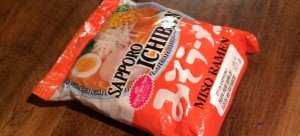She denies it. But I’ll swear that Lee Duberman has some Asian blood in her. Look at those eyes. Don’t they look a little slanted to you?
In Toronto, once a week, every week, I have a bowl of ramen. In San Miguel de Allende, once a day, every day, I dream of having a bowl of ramen. Who could make my dream come true? Lee Duberman, of course. She’s made me shu mai. She’s made me chicken and chive pot stickers. She’s made me steamed pork belly buns. She’s made me Thai noodles. She’s made me virtually everything tasty Asian, Surely she could make me ramen.
But how could I make it happen? I couldn’t get or afford to have Lee Duberman cater for just Don Day’s Wife and I.
Then it hit me. I’d have Lee cater a Japanese meal for the gentlemen who lunch. And I’d ask her husband, sommelier Richard Fink to choose and serve something apropos to wash it down.
Next, as my house lay buried under a mountain of construction materials, I needed a place to hold it. Fellow gentleman Chip Swab happened to be sat next to me (always sit next to Chip if you can for he usually has two glasses of wine). Ever the gentleman, Chip volunteered his home.
Nineteen of us warmed up our Japanese appetites with some Gyoza dumplings stuffed with shrimp and pork as we watched Lee prep all of the ingredients for the ramen.
A hearty, meaty broth full of emulsified fats and proteins. Braised pork shoulder. Vegetable greens. Eggs. Scallions. Noodles. And pork belly.
But before I tell you about Lee Duberman’s ramen, I should tell you a little about ramen in general. Its popularity in North America began about 20 years ago with cello packages of instant ramen that, at about a buck a pack, quickly rivalled mac and cheese as the favorite fast dinner in college dorms.
The instant ramen noodle was, in fact, voted as the greatest Japanese export of the 20th century in a national poll, placing it ahead of the Honda Civic and the Sony Walkman.
Then, about five years ago, real ramen arrived from Japan. To the best of my memory, in 2011, in Toronto, there was exactly one ramen restaurant. Now, there are almost one hundred. I’d be happy with just one in San Miguel. And could you perhaps hire Lee Duberman as your chef?
I have personally declared ramen as the most difficult dish to consume while maintaining an air of sophistication and Lee Duberman’s was no different.
Her noodles were fat and springy. Her broth was rich in sodium but not too salty. Her egg was cooked to that exact moment between hard and soft. Her veggies were crisp and crunchy. And her pork was scrumptious. What I liked most about it was the clean, refreshing taste you got from such a hearty broth.
Meanwhile, Richard Fink was filling our glasses with another form of liquid pleasure. Richard and Lee own Ariel’s, a fair-weather-only restaurant in Vermont and spend their autumns and winters doing pop-ups and catering jobs in San Miguel. Lee rules in the kitchen. Richard rules the rest.
Richard gave us a choice of red or white, a 2014 Karl Kaspar Riesling from Germany or a 2013 Vina Maipo Syrah from Chile.
Richard told me, “I consider both to be great values, the Syrah for casual everyday use, the Riesling for almost any occasion.”
Most of us chose the Riesling, at least to start. Riesling used to be the second most popular white grape when I first started drinking wine about a half century ago. Now, it’s one of the most neglected. I rarely see anyone buy it yet everyone seems to rave when they drink it.
“The Karl Kasper is everything I ask of a simple Riesling. It’s a perfect balance of fruit, sweetness and acidity,” said Richard. “It’s incredibly versatile, will go with just about anything and at 8.5% alcohol you can drink a lot of it. Yaaaaay!
“It’s a bit white grapey, citrusy and Granny Smith appley. For those who don’t think they like Riesling as in yuck it’s too sweet, they should try this. When La Europea is out of this, I’m heartbroken.”
I’d never had the Karl Kasper Riesling before but the Maipo Syrah is an old favorite that’s got lots of blackberry and chocolate in the taste.
Richard said, “The Syrah is, as they say, “made correctly”. It’s not gussied up with oak, over extraction or extended hang time. It’s a fairly pure representation of Syrah, light to medium bodied, not particularly tannic, somewhat elegant, not overly alcoholic, and leaning towards damson plum in flavor.
“It reminds me of some simple St. Josephs or Crozes Hermitages from the northern Rhone.
“It’s perfectly serviceable, pleasant, lasts after opening for a couple of days and never leaves me asking why did I drink this.”
Like the Riesling, Vina Maipo Syrah is available at La Europea. And here comes the best part. The Riesling is priced at 67 pesos. The Syrah is priced at 74 pesos. Now you might not find them in La Europea’s San Miguel de Allende store. You might have to drive to Queretaro. And if Richard Fink has been there recently, you might not find them there either.
I can tell you a way to taste Lee Duberman’s Asian cooking though. For their last event before they head back to Vermont, Lee and Richard are hosting what they’re calling A Walk Around Asian Street Food Festival this Saturday, March 12.
The menu will include siu mai, pot stickers, skewers of chicken and lamb, steamed buns with pork belly or vegetarian fillings, pad thai and more. The event is a fundraiser for Lee and Richard’s new company, Second Act Productions, which will be staging its first production, Little Shop Of Horrors: The Musical, next December. The walk around will be held in the courtyard of Casa Carly, 48 Calzada de la Aurora, from 4:00 to 7:00 pm.
For information about Lee and Richard’s last chance for Asian this winter, email them at info@arielsrestaurant.com and ask for the flyer with all the details.















Without a doubt, one of the best lunches of the year. Often in TO, the server will ask if you want the egg in or out. I’ve always assumed that perhaps that option is for those who are new to the dish and might consider what they thought to be a “half cooked” egg to be somewhat odd in their “soup”. Good for Lee for not providing that option.
How does one participate in the gentlemen who lunch gatherings?
The group has already grown a little too big and most restaurants are having problems handling our size so, at least for now, we’re not adding anybody.
Sorry.
Do you really need to say that about “slanty eyes”?? It’s offensive in a careless way, trying to be funny at the expense of an ethnic barb. You can (and ought) to do better.
I’m Asian and I wasn’t offended at all! Just saying…